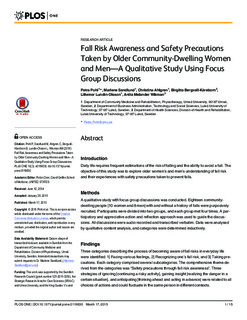| dc.contributor.author | Pohl, Petra | |
| dc.contributor.author | Sandlund, Marlene | |
| dc.contributor.author | Ahlgren, Christina | |
| dc.contributor.author | Bergvall-Kåreborn, Birgitta | |
| dc.contributor.author | Lundin-Olsson, Lillemor | |
| dc.contributor.author | Melander-Wikman, Anita | |
| dc.date.accessioned | 2017-06-07T12:40:03Z | |
| dc.date.available | 2017-06-07T12:40:03Z | |
| dc.date.issued | 2015 | |
| dc.identifier.citation | Pohl, P., Sandlund, M., Ahlgren, C., Bergvall-Kåreborn, B., Lundin-Olsson, L. & Melander-Wikman, A., (2015) Fall risk awareness and safety precautions taken by older community-dwelling women and men: a qualitative study using focus group discussions. P L o S One, 10(3). | |
| dc.identifier.issn | 1932-6203 | |
| dc.identifier.uri | http://hdl.handle.net/11250/2445124 | |
| dc.description | Artikkelen omhandler en studie hvor hensikten var å undersøke eldre menn og kvinners forståelse av fallrisiko og deres erfaringer med sikkerhetsforhåndsregler som ble gjort for å forhindre fall. | |
| dc.description.abstract | INTRODUCTION: daily life requires frequent estimations of the risk of falling and the ability to avoid a fall. The objective of this study was to explore older women's and men's understanding of fall risk and their experiences with safety precautions taken to prevent falls. METHODS: a qualitative study with focus group discussions was conducted. Eighteen community-dwelling people [10 women and 8 men] with and without a history of falls were purposively recruited. Participants were divided into two groups, and each group met four times. A participatory and appreciative action and reflection approach was used to guide the discussions. All discussions were audio recorded and transcribed verbatim. Data were analysed by qualitative content analysis, and categories were determined inductively. FINDINGS: three categories describing the process of becoming aware of fall risks in everyday life were identified: 1] Facing various feelings, 2] Recognizing one's fall risk, and 3] Taking precautions. Each category comprised several subcategories. The comprehensive theme derived from the categories was "Safety precautions through fall risk awareness". Three strategies of ignoring [continuing a risky activity], gaining insight [realizing the danger in a certain situation], and anticipating [thinking ahead and acting in advance] were related to all choices of actions and could fluctuate in the same person in different contexts. CONCLUSIONS: the fall risk awareness process might be initiated for various reasons and can involve different feelings and precautions as well as different strategies. This finding highlights that there are many possible channels to reach older people with information about fall risk and fall prevention, including the media and their peers. The findings offer a deeper understanding of older peoples' conceptualizations about fall risk awareness and make an important contribution to the development and implementation of fall prevention programmes. | |
| dc.language.iso | eng | |
| dc.rights | Navngivelse 4.0 Internasjonal | |
| dc.rights.uri | http://creativecommons.org/licenses/by/4.0/deed.no | |
| dc.subject | Sverige | |
| dc.title | Fall risk awareness and safety precautions taken by older community-dwelling women and men: a qualitative study using focus group discussions | |
| dc.type | Journal article | |
| dc.type | Peer reviewed | |
| dc.rights.holder | Pohl, Petra | |
| dc.identifier.doi | 10.1371/journal.pone.0119630 | |

